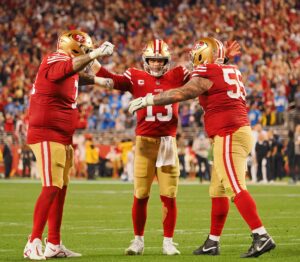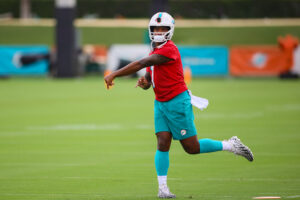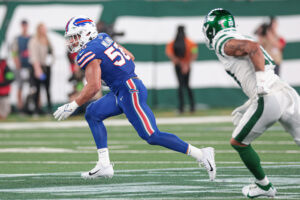In many ways, the 2020-21 NFL season was an era-defining year for the New York Giants. Under the leadership of first-year head coach Joe Judge, the Giants took big steps forward and finally moved on from the Eli Manning years. Judge and defensive coordinator Patrick Graham have revamped the team’s defense. After losing Saquon Barkley to a season-ending knee injury, Big Blue turned to Wayne Gallman and veteran running Alfred Morris to create a two-headed monster at running back. The Giants were even able to compete for the NFC East title with a record of 6-10. But going into this off-season, a huge question remains unanswered at quarterback. Is Daniel Jones the long-term answer under center? If yes, what must Daniel Jones do in the off-season to become a more reliable dual-threat quarterback?
Daniel Jones Breakdown After Two NFL Seasons
Rookie Season
After being the number six overall selection in the 2019 NFL draft, the expectations for Jones were sky-high. The organization and fans expected him to immediately be the heir apparent to Eli Manning. Jones has a lot in common with Manning, but with an important difference. Jones is much more mobile than Manning was. But in Jones’ first season as Giants quarterback, in Pat Shurmur’s offense, he did not use his legs that often. In 13 starts Jones completed 61 percent of his passes and threw for over three thousand yards and 24 touchdowns. He added 280 yards on the ground and two rushing touchdowns. At times Jones showed an ability to escape the rush, but his first-year highlights were mainly from the pocket. For all the good in year one, Jones was turnover prone and he threw 12 interceptions.
Second Year
In Jones’ second year, his first as the Giants full-time starter, he led a brand new offense. Joe Judge hired Jason Garrett as his offensive coordinator, who instituted a combination of his Dallas Cowboys scheme with run/pass/option (RPO) concepts. It’s hard enough to master a new offense under normal circumstances, but NFL teams were forced to adhere to strict COVID-19 protocols that affected training camps and weekly practice schedules. In addition, the preseason was canceled.
Jones’ 2020-21 performance was mediocre at best. He threw for only 2,943 yards and 11 touchdowns. Plus, he continued to be turnover-prone and threw 10 more interceptions. On the positive side, with the new RPO concepts in the offense, Jones rushed for over 400 yards and a touchdown. His 423 yards included a season-long 80-yard rush where he reached a top speed of 21.23 mph during that dash. It’s the fastest top speed by any quarterback since the 2018 season. Up until October 2o20, Jones has led the Giants in rushing in seven games, the most by a Giants quarterback in the Super Bowl era. The only other NFL quarterback to be his team’s rushing leader more is Baltimore Ravens signal caller Lamar Jackson, who has done it 12 times. Once again, Daniel Jones showed flashes of becoming a dominant dual-threat quarterback, but he was unable to do so on a consistent basis.
Room for Improvement
As a passer, Daniel Jones has shown a willingness to stand in the pocket and deliver the ball. Jones is accurate and while he doesn’t have the strongest arm in the league, he can get the ball down the field. His weakness as a quarterback is more mental than a lack of skills. Jones wants to be a playmaker, but his pocket awareness and decision-making need to improve. Jones has a tendency to hold onto the ball too long and force throws into coverage. In order for Jones to take the next step, he needs to better anticipate the rush. Jones looks confused when he’s blitzed at times. He must learn to throw the ball away to avoid a sack or take better advantage of his check downs. He has shown functional mobility in the pocket in spurts, he just needs to do it more often.
The Giants could help Jones improve by acquiring a legitimate number one receiver and shore up the offensive line.
As a rusher, Jones is deceptively quick for his size. But at 6’5 and over 220 pounds, he is a big target for defenses. Steve Young, one of the best dual-threat quarterbacks in the history of the NFL, has been outspoken about mobile quarterbacks and what skills they need to win championships. In an interview with the San Francisco Chronicle after his playing days ended, Young said, “You’re already a dual-threat because you can leave the pocket and make throws.” “Obviously, you can run for a bunch of yards. But are you the master of the main event, which is the job? The job is to deliver the ball from the pocket. It’s been proven to me over and over again that that’s the championship job.”
Last Word
The Giants offense could feature Jones’ skills as a runner more predominately, but that style of offense comes at a price. Jones isn’t as dynamic as Lamar Jackson, Kyler Murray, or Michael Vick. His mobility can be defended. When defenses take away running lanes, Jones must become a better signal-caller from the pocket. Plus, the NFL is the ultimate team sport, and one player can’t win championships on his own. Murray hasn’t won, yet, Vick never won one, and while John Elway and Steve Young won Super Bowls, they led great team offenses from the pocket.
It may seem illogical, but Daniel Jones must actually rely less on his legs to become a better dual-threat quarterback. If he does he may have a better NFL future.
Main Photo






